100 Days of Franklin - Week 6: Foot and Ankle
The foot/ankle chapter in DATI is the densest so far. Let’s hope this summary makes sense to you.
See you tomorrow and may you always have your best foot forward!
Day 36
Roll your feet and ankles
- toes side to side
- heel side to side
- front to back
- pinching round the edges
- top of the foot
- compare left and right (can you let the unrolled foot borrow some of the happiness from the rolled foo?)
- repeat on the other side
Review what you know of foot and ankle anatomy
Roll your achilles heel and calf
- place an orange ball underneath your achilles heel (finding a comfortable position for this can be challenging)
- flex and extend your foot 15 times (carrying the flexion and extension all the way into the toes)
- move the ball to the lower calf and repeat
- move the ball to the upper calf and repeat
- compare left and right
- repeat on the other side
Day 37
Among the many bones of your foot, the top one is the talus. This articulates with the rest of your foot distributing force to the heel and to the ball. It also articulates with the tibia and fibula.
The tibia and fibula form a tunnel for the talus to fit in (the bony points that stick out to either side of the talus, the maleola are the “outside” of this tunnel). The tibia forms the arch and medial (inner) side and is the main weight bearer. The fibula forms the outer side and is used for making smaller adjustments.
Pointing your foot out is called plantar flexion, while bending your foot towards your shin is called dorsiflexion.
While sitting, flex/extend your right foot. Imagine your talus as being held between the pincers formed by your tibia and fibula. During dorsiflexion, the talus moves relatively backward. During plantar flexion, the talus moves relatively forward. Because the talus is wider at the front, the pincers widen during dorsiflexion. Imagine how this widening stores energy in the ligaments and muscles, softening landings which flex your ankles, and preparing you to spring back.
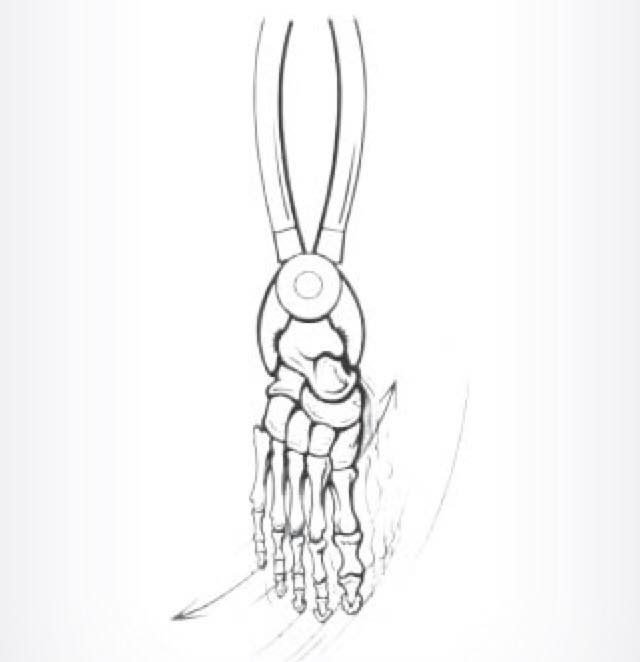
Imagine your tibia and fibula are saloon doors. In dorsiflexion, the talus pushes through them at the front. In plantar flexion, the talus pushes through them at the back.
Stand and compare sides. Repeat on the other side.
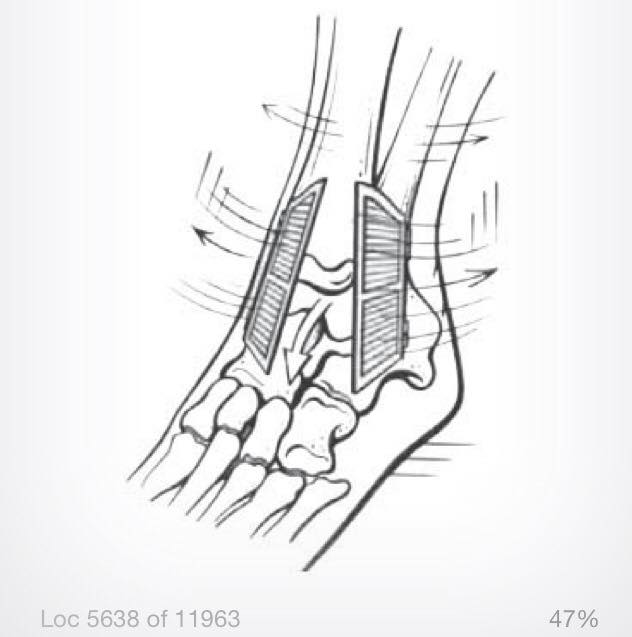
Day 38
Repeat rolling from monday and flexing with talus imagery from yesterday.
As you flex in both directions identify the axis of rotation of your ankle joint. Use a pencil to try to identify its direction.
SPOILER: it runs from a point 5mm below the inner (or medial) maleolus to a point 3mm below and 8mm in front of the tip of the fibula (outer or lateral maleolus). So from inside to outside, the line goes backwards and down. This offset angle allows the foot to reflect the femur rotation on flexion. (just as the knee condyles form a cone with the smaller wheel outside, the talus is a cone with the smaller section inside). Note that because of this movement, the instruction “keep your knee over your second toe” does not account for the dynamics of the ankle joint (the rotation means that it holds true at a certain point - and probably on average - but that the literal tracking will end outward of where it starts).
Imagine your tibia and fibula as being two hands, cupping your talus. The bigger tibia covers the top with its palm and the side with its finguers. The smaller fibula just covers the side with its fingers. Move your ankle in all directions, imagining the movement is generated from the adjusting fingers of the fibula.
Picture the membranes between the tibia and fibula as a sail, billowing in the wind, with the wind coming first from the front, then from the back, and then constantly alternating directions.
Although the fibula articulates with the side of the talus, the talus presents a small, almost horizontal surface for it to “lean” on. In dorsiflexion, this surface pushes the fibula “up”. At the other end of the fibula, the fibula moves backwards slightly in order to not push against the underneath of the tibial plateau. At the same time, the fibula rotates inwards (and moves relatively forward compared to the talus).
Do some more movement and flexion, imaging one or more of these functions, and using touch and tapping to help the ankle relax into these movements.
https://www.youtube.com/watch?v=IAR3BsYy4RQ
Day 39
Today we’ll start on the foot. From the talus (ankle bone), which is arch shaped, we go back to the calcaneus (heel) and forward to the navicular. The foot can then be thought of in two parts.

The ankle/inside/upper part is responsible for locomotion and springyness. It goes forward from the talus to the first three toes, via the navicular, three cuneiforms, three metatarsals and the phalanges of the first three toes. Above the talus it relates most to the tibia.
The heel/outside/bottom part is responsible for stability and support. From the calcaneus (heel) it goes forward to the 4th and 5th toe, via the cuboid, two metatarsals and two sets of phalanges. Above the calcaneus it relates most to the fibula (via the talus). When we walk, the heel and outside of the foot get first contact, to ensure a stable base, aware of the terrain and any instability. As we roll through, weight is transferred and absorbed into the ankle and the inside of the foot. In turn the energy absorbed by the inner foot is returned for propulsion into the next step. Imagine your whole foot as being a chain of bones linked by springs. The foot can absorb a lot of energy without injury because it is distributed among many joints and bones. Walk, imaging one side with those two images
- springs,
- heel/outside for first contact and support, ankle/inside for force absorbtion and restitution. After a while, compare then change sides.
https://www.youtube.com/watch?v=FP9NTjYDQNA
Day 40
Extend your hand out as if to give something to someone, palm up. Now bring your hand back in and palm down, as if taking something back. Do the same rotating only at the wrist. The first movement, of giving your palm is called “supination”. The second movement of taking your palm is called “pronation”. French speakers can think of the second as “prendre”. You can also think that that supination is when you hold a bowl of soup. In pronation, you are prone to spill it (hat tip to Vera).
You can do the same thing with your foot. If you roll it side to side, the rotation that would bring the sole of your foot in and eventually up is supination (if you are standing, you end up balancing on the “side” of your foot - s for supination), the movement that brings your foot increasingly sole down is pronation.
Stand and bring your feet into supination (you’re balancing on the outside/lateral side of your feet). As you do this, notice what happens to your sacrum. Then roll all the way back into pronation and notice what happens to your sacrum. Why is that?
The spiral rotations of the legs as you plié extend all the way down into the feet. From a sitting position, so that you can freely observe the axis of flexion, dorsiflex and plantar flex a few times. Notice that the axis of flexion causes dorsiflexion to be accompanied by pronation, while plantar flexion is accompanied by supination. This rotation matches that of the tibia and fibula in plié, as it carries through into the foot. As you plié, they rotate so that the front/top move toward the inner side. This rotation is important so that the spiral is balanced all the way through the leg. As you noticed above, if your feet remain supinated in plié, the other spirals will not work well, and the pelvis will stay wide at the front and narrow at the PSIS and sitbones, refusing to let your sacrum nutate. And a sacrum that doesn’t nutate will not let the lumbar curve form and will affect your spine’s ability to do it’s job.
The unrolling of the foot in pronation is also the action that allows the foot to absorb and return force, in plié and in walking. Image your foot rolling in (pronation) as you plié and out as you extend (supination).
The movement of pronation with the sole of your foot on the ground allows the arch of the foot to unroll, with the mid of the foot rotating inward and the ball and toes of the foot rotating relatively outward, laying the foot flat on the ground. The movement of supination rotates the mid of the foot outward, while the ball and toes of the foot rotate relatively inward, reforming the arch of the foot.
Imagine your foot as a chain of metal links. These links allow the chain to be supple. If you twist the chain, it will become increasingly rigid. The foot’s normal state is to be a slightly twisted chain. As you unroll it (pronation with the ball of the foot on the ground), it becomes more supple and stores energy in the muscles and ligaments, ready to return to its naturally twisted state. As you twist it further (supination with the ball of the foot on the ground), it becomes more rigid, forming a strong base from which to finalize the push off into the next step.
Day 41
Constructive rest saturday. Before going into constructive rest, roll your feet. Lie in constructive rest, if possible with your calves resting on a chair and your feet hanging free, and review what you know of your ankle and foot structure. How much more do you know than on monday? Without moving, imagine the different movements of the ankle and foot. Dorsiflexion and plantar flexion of the foot:
- the talus moving relative to the tibia and fibula (back in dorsal, forward in plantar)
- the inward rotation of the tibia on dorsal (moving with the talus - more on that tomorrow), and the extra rotation of the fibula
- the movement of the fibula coming cranially in dorsiflexion and caudally in plantar flexion All around movement of the foot. Picture the role of the fibula as the root of this movement. In supination and pronation, imagine your foot un twisting in pronation, and twistins back in supination. Feel the extra rigidity in supination and the extra flexibility in pronation. Imagine your foot untwisting working “against” all the muscles and ligaments of your foot, storing energy in them, read to bounce back.
Day 42
Today we’re going to look at the subtalar joint. It’s where a large part of the action happens and it’s quite complex (and when it’s described in terms of planter flexion, adduction, etc. it really confuses me). I’m going to give you my distilled summary, which hopefully makes sense (but you should take with a grain of salt).
The talus (ankle) lies on top of the calcaneus (heel). The talus is not actually attached to any muscles, so all its movements are relative to the way it moves against the tibia, calcaneus and navicular. I’m not going to bother too much whether any of the described movements literally happens relative to the ground. (I’m also going to stick to closed chain - foot on the ground - and not go into what happens in open chain).
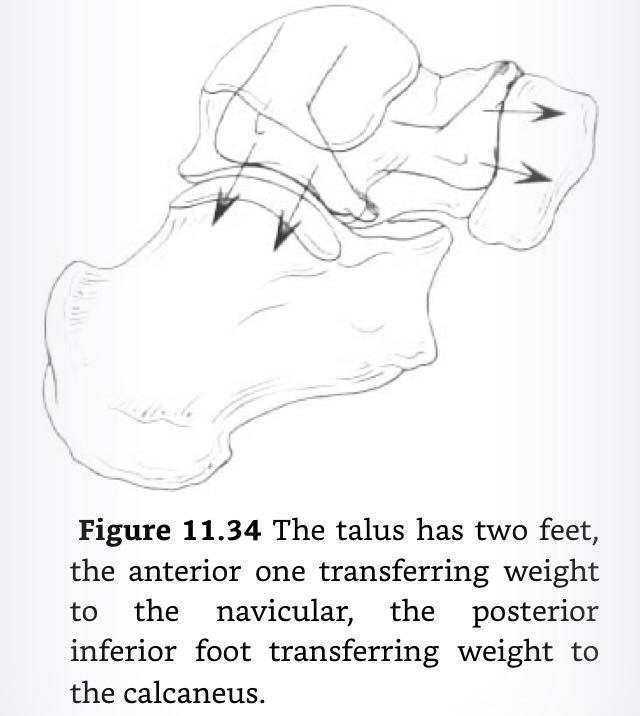
In the unrolling of the foot (from transferring weight on it, or from dorsiflexion in plié), the calcaneus goes in a kind of spiral (clockwise and down/out for the right foot). The talus goes in an opposite spiral (counter clockwise and down/in for the right foot). We can decompose this movement 3 ways (and it is reversed in the other direction as weight is removed/plantar flexion happens).
First, rotation in a mostly horizontal plane/vertical axis. The heel/outer foot fans out. The ankle/inner foot fans in (the fan spreads out at the toes, so both sides fan “out”, but one the first laterally and the second medially). In this rotation, the talus seems to accompany the rotating in of the tibia (though I think there is some extra inward rotation of the tibia and especially fibula, relative to the talus).
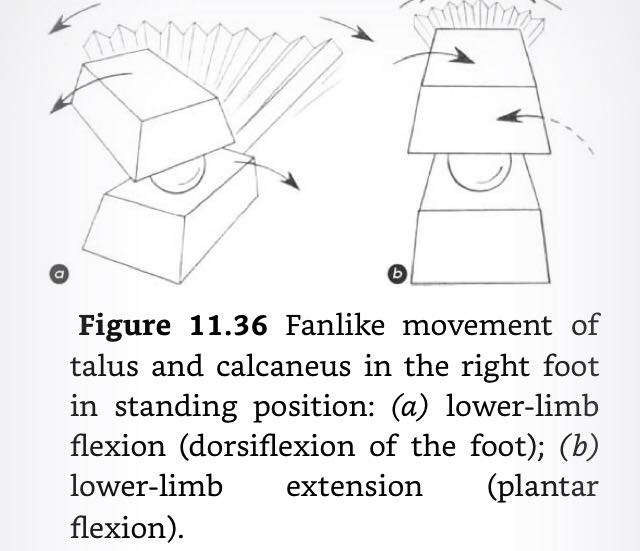
Second, rotation in the “sub-foot” axis. The calcaneus pronates, rotating on the heel-towards-little-toe axis. This motion happens in the direction where you are holding a bowl of soup in the Palm of your hand, and flip it so it Pours out. The talus “supinates”. In the talus-to-big-toe axis, it rotates relatively in use a Spoon to Scoop some Soup from a bowl direction.
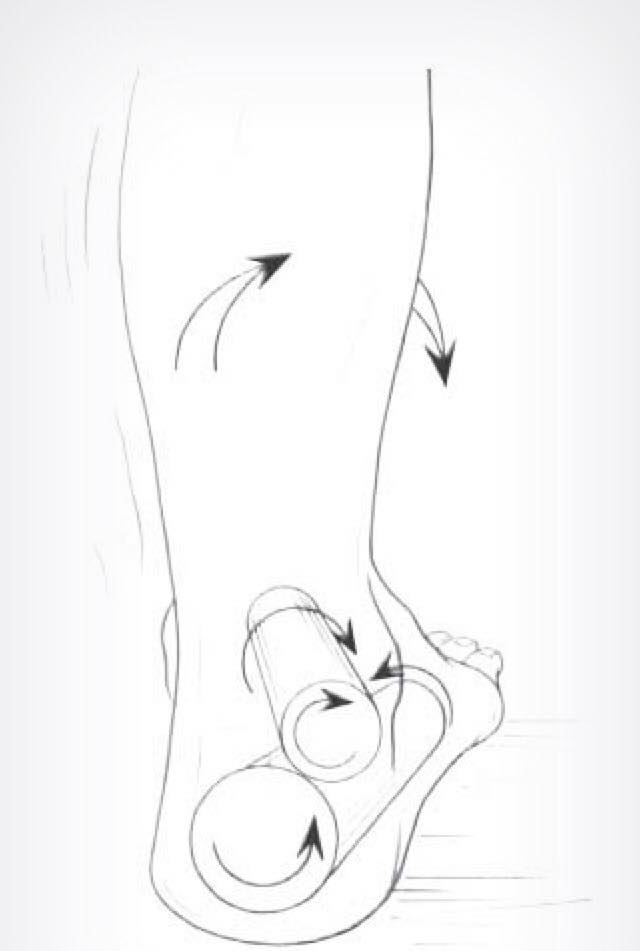
Place your two hands one on top of each other (representing the right foot with right hand on top to represent the talus, and left hand representing the calcaneus), palm down, slightly fanned out to represent the two axes. As you pronate your left hand (the right foot calcaneus is supinating, but you’re representing it with the other hand, so pronate), it rolls against your right hand. The result is that they move relatively apart - you can imagine how this could create a force absorbing movement. Last, the talus slides forward and down ,”off” the calcaneus, and the calcaneus slides back. Now put all these together (my brain ‘sploded). As you are walking or plié/extend-ing, think
- fan opens, fan closes
- heel pronates, heel supinates
- ankle supinates, ankle pronates
- ankle slides forward, heel slides back
- heel spirals clockwise (right foot), heel spirals counter-clockwise
- ankle spirals counter clockwise (right foot), ankle spirals clockwise.
And of course, then the rest of the foot moves. In closed chain, the front of the foot, starting at the navicular and cuboid moves counter to the heel, in order to stay flat on the ground. So relatively to the ankle, when it pronates, the front foot supinates. You can also think of the front of the foot as a loosely tied log raft, which adaptes to even the most stormy sea.